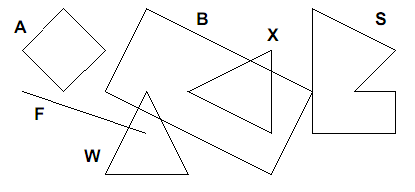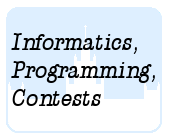Подразделы
Другие разделы
| 753. Catch the Bus! |
| 754. Calendar of Events |
| 755. Roman Expressions |
| 757. Corporate Identity |
| 758. Money Money Money, Must Be Funny |
| 759. Railway Transportation |
| 760. Soccer Tournament |
| 761. Hypertheseus |
Дата и время
18/12/2025 03:36:48
 756. Geometric Shapes
756. Geometric Shapes
 Задача
Задача
 Геометрия
ГеометрияОлимпиадные задачи на английском языке

| 04/02/2008 | Зима 2008 дорешивание (1g) |
| 04/02/2008 | Тренировка (задачи CTU Open Contest 2007) (g) |
Ограничения: время – 2s/4s, память – 64MiB Ввод: input.txt или стандартный ввод Вывод: output.txt или стандартный вывод 
Послать решение Blockly Посылки Темы Где Обсудить (0)
While creating a customer logo, ACM uses graphical utilities to draw a picture that can later
be cut into special fluorescent materials. To ensure proper processing, the shapes in the picture
cannot intersect. However, some logos contain such intersecting shapes. It is necessary to detect
them and decide how to change the picture.
Given a set of geometric shapes, you are to determine all of their intersections. Only outlines
are considered, if a shape is completely inside another one, it is not counted as an intersection.

Input Specification
Input contains several pictures. Each picture describes at most 26 shapes, each specified on
a separate line. The line begins with an uppercase letter that uniquely identifies the shape
inside the corresponding picture. Then there is a kind of the shape and two or more points,
everything separated by at least one space. Possible shape kinds are:
- square: Followed by two distinct points giving the opposite corners of the square.
- rectangle: Three points are given, there will always be a right angle between the lines connecting the first point with the second and the second with the third.
- line: Specifies a line segment, two distinct end points are given.
- triangle: Three points are given, they are guaranteed not to be co-linear.
- polygon: Followed by an integer number `N` `(3\ ≤\ N\ ≤\ 20)` and `N` points specifying vertices of the polygon in either clockwise or anti-clockwise order. The polygon will never intersect itself and its sides will have non-zero length.
All points are always given as two integer coordinates `X` and `Y` separated with a comma and
enclosed in parentheses. You may assume that `|X|,\ |Y|\ ≤\ 10000`.
The picture description is terminated by a line containing a single dash ('-'). After the last
picture, there is a line with one dot ('.').
Output Specification
For each picture, output one line for each of the shapes, sorted alphabetically by its identifier
(`X`). The line must be one of the following:
- "`X` has no intersections", if `X` does not intersect with any other shapes.
- "`X` intersects with `A`", if `X` intersects with exactly 1 other shape.
- "`X` intersects with `A` and `B`”, if `X` intersects with exactly 2 other shapes.
- "`X` intersects with `A`, `B`, …, and `Z`”, if `X` intersects with more than 2 other shapes.
Please note that there is an additional comma for more than two intersections. `A`, `B`, etc. are
all intersecting shapes, sorted alphabetically.
Print one empty line after each picture, including the last one.
Sample Input
A square (1,2) (3,2) F line (1,3) (4,4) W triangle (3,5) (5,5) (4,3) X triangle (7,2) (7,4) (5,3) S polygon 6 (9,3) (10,3) (10,4) (8,4) (8,1) (10,2) B rectangle (3,3) (7,5) (8,3) - B square (1,1) (2,2) A square (3,3) (4,4) - .
Sample Output
A has no intersections B intersects with S, W, and X F intersects with W S intersects with B W intersects with B and F X intersects with B A has no intersections B has no intersections

 Начало
Начало